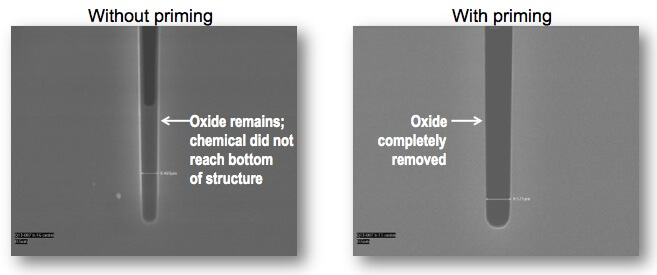Sometimes, it’s the seemingly little things that make all the difference. Like for example, who knew that thoroughly drying a wafer is critical to cleaning post TSV etch to achieve optimal surface preparation? At IWLCP 2013 last week, I spoke with Ismail Kashkoush, Ph.D., Akrion Systems’ V.P. of Products and Technology, who presented a paper, Vacuum-Assisted Wet Processing for Advanced 3D Devices, co-written by Jennifer Rieker of Akrion’s technology department along with Damien Michel and Patrick Daoust of Teledyne DALSA Semiconductor and Irina Stateikina of The MiQro Innovation Collaborative Centre (C2MI). The paper addressed the challenges for surface preparation created by high aspect ratio (HAR) through silicon vias (TSVs), and how Akrion’s vacuum systems enable complete wetting and drying of high aspect ratio structures.
Akrion designs and builds flexible batch immersion and single-wafer surface preparation equipment for the semiconductor, MEMS, solar and related industries. Historically focused on front-end and back-end processes, the company has recognized a need in the wafer level and 3D TSV space, and in particular for high aspect ratio TSVs. About two years ago, Akrion began development of tool features specifically developed to meet these challenges in the market. The company is a member of the C2MI consortium, and currently has 3 tools placed at the Canadian research center.
 Kashkoush gave me a crash course in Akrion’s technology. On 3D InCites, we’ve talked about the importance of cleans for 3D IC, particularly for resist removal after bumping, and post TSV DRIE etch, to remove any contaminants that could get in the way of depositing a good film for the barrier and seed layers. Kashkoush explained that watermarks are included in the list of potential contaminants, which is why thoroughly drying the surface of the vias is critical. Additionally, when introducing etch and cleaning chemistries into HAR vias (>10:1) to begin with, the amount of air inside those structures increases and can create enough pressure so as to prevent full penetration of the chemistry to the bottom of the via. It’s important to note that for vias <10:1, conventional cleaning/etching methods were sufficient, which is likely why we haven’t heard about it up until now.
Kashkoush gave me a crash course in Akrion’s technology. On 3D InCites, we’ve talked about the importance of cleans for 3D IC, particularly for resist removal after bumping, and post TSV DRIE etch, to remove any contaminants that could get in the way of depositing a good film for the barrier and seed layers. Kashkoush explained that watermarks are included in the list of potential contaminants, which is why thoroughly drying the surface of the vias is critical. Additionally, when introducing etch and cleaning chemistries into HAR vias (>10:1) to begin with, the amount of air inside those structures increases and can create enough pressure so as to prevent full penetration of the chemistry to the bottom of the via. It’s important to note that for vias <10:1, conventional cleaning/etching methods were sufficient, which is likely why we haven’t heard about it up until now.
 The two-step process involves vacuum priming and vacuum drying, explained Kashkoush. First, prior to wet etch or cleaning, a vacuum “priming” step pulls any remaining air out of the cavity to enable full wetting of the via so the etch/cleaning chemistries can do their job. Post clean, vacuum is used to pull away any residual wet moisture following the rinse step. Why doesn’t air drying work? “Because you can’t blow hard enough to get to deep trenches. And even if you do, there will be many water marks (or stains) which is another undesired contaminant.” he explained. These two processes together leave surfaces ready for the next process step without damage.
The two-step process involves vacuum priming and vacuum drying, explained Kashkoush. First, prior to wet etch or cleaning, a vacuum “priming” step pulls any remaining air out of the cavity to enable full wetting of the via so the etch/cleaning chemistries can do their job. Post clean, vacuum is used to pull away any residual wet moisture following the rinse step. Why doesn’t air drying work? “Because you can’t blow hard enough to get to deep trenches. And even if you do, there will be many water marks (or stains) which is another undesired contaminant.” he explained. These two processes together leave surfaces ready for the next process step without damage.























